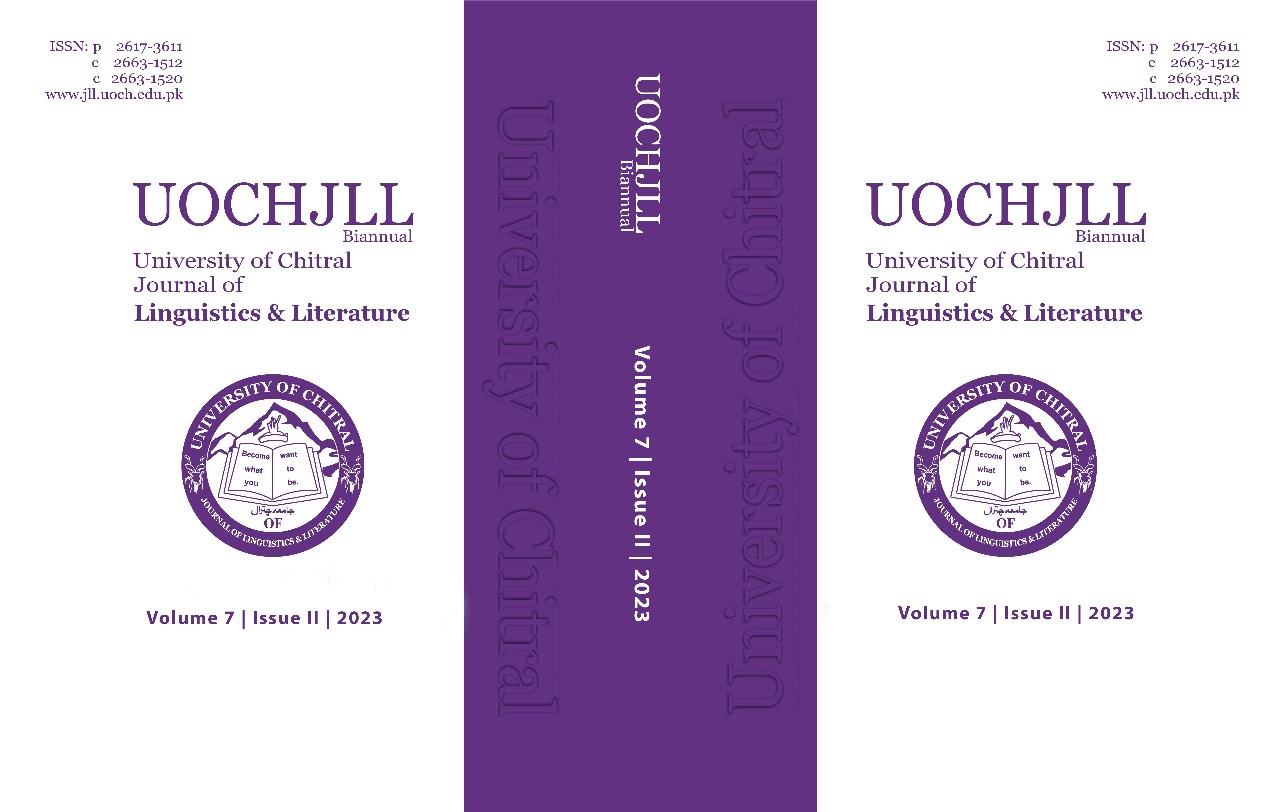Exploring the stories-we-live-by in the Era of Generative AI: An Ecolinguistic Study
Keywords:
Generative AI,, stories-we-live-by, ecolinguistics, ecological concernsAbstract
Within the domain of artificial intelligence (AI), an intriguing and frequently disregarded dichotomy emerges: a comprehensive examination of the relationship of humans and AI co-existing with a noticeable dearth of attention towards environmental factors. This study presents an in-depth ecolinguistic analysis of discourses surrounding Generative AI, humans, and social structures including non-human objects. Utilizing a five-step textual analysis proposed by Altheide and Schneider (2013), this qualitative study investigates linguistic expressions in panel discussions featuring technologists, historians, and academicians from November 2022 to the present. By applying Stibbe’s ecolinguistic tool of “stories” (2015), the research methodology involves analyzing transcripts to identify constructive and destructive stories. The analysis highlighted how technologists, historians, and academicians contributed to the creation of three different types of stories in their panel discussions. These three stories were: AI is beneficial, AI is extinction, and AI is extractive. This study highlights the importance of inclusive narratives in technological discussions, particularly considering the ecological impacts of AI advancements. The study’s findings reveal a conspicuous erasure of environmental concerns in AI discourses, highlighting the need for greater ecological consciousness in technological development and discourse.
References
Altheide, D. L., & Schneider, C. J. (2013). Qualitative Media Analysis. Sage Publications.
Bahrammirzaee, A. (2010). A comparative survey of artificial intelligence applications in finance: artificial neural networks, expert system and hybrid intelligent systems. Neural Computing and Applications, 19(8), 1165-1195.
Berardi, F. (2012). The Uprising: On Poetry and Finance. Semiotext(e).
Borgmann, A. (1984). Technology and the Character of Contemporary Life: A Philosophical Inquiry. University of Chicago Press.
Brynjolfsson, E., & McAfee, A. (2014). The Second Machine Age: Work, Progress, and Prosperity in a Time of Brilliant Technologies. W. W. Norton & Company.
Chuan, C. H., Tsai, W. H. S., & Cho, V. (2019). The determinants of media portrayal of the AI risks: Evidence from the UK online media and Newspapers. Technological Forecasting and Social Change, 149, 119752.
De Boer, B. (2018). Understanding Post-Phenomenology Through Technology: Post-Phenomenological Investigations. Rowman & Littlefield.
Deetz, S. (1977). Phenomenology in Communication Research. Human Studies, 1(1), 235-259.
Duan, Y., Edwards, J. S., & Dwivedi, Y. K. (2019). Artificial intelligence for decision making in the era of Big Data – evolution, challenges and research agenda. International Journal of Information Management, 48, 63-71.
Ellul, J. (1962). The Technological Society. Vintage Books.
Fill, A., & Mühlhäusler, P. (2001). The Ecolinguistics Reader: Language, Ecology, and Environment. Continuum.
Gertz, N. (2018). Nihilism and Technology. Rowman & Littlefield International.
Harari, Y. N., & Bengio, Y. (2023). Artificial Intelligence, Democracy, and the Future of Civilization. [Panel Discussion].
Haugen, E. (1987). Ecological Linguistics. In A. Fill & P. Mühlhäusler (Eds.), The Ecolinguistics Reader: Language, Ecology, and Environment (pp. 57-66). Continuum.
Heidegger, M. (1977). The Question Concerning Technology, and Other Essays. Harper & Row.
Kaplan, A., & Haenlein, M. (2020). Siri, Siri, in my hand: Who’s the fairest in the land? On the interpretations, illustrations, and implications of artificial intelligence. Business Horizons, 63(1), 15-25.
Kingsnorth, P., & Hine, D. (2009). The Dark Mountain Manifesto. Dark Mountain Project.
Korten, D. (2006). The Great Turning: From Empire to Earth Community. Berrett-Koehler Publishers.
Li, W., Steffenson, S. V., & Huang, G. (2020). Ecolinguistics: Towards an ecological understanding of language. Applied Linguistics Review, 11(4), 555-574.
Lu, L. (2019). From computational intelligence to Web intelligence: An empirical study. Computer Networks, 50(4), 1767-1779.
McCorduck, P. (2004). Machines Who Think: A Personal Inquiry into the History and Prospects of Artificial Intelligence. A. K. Peters/CRC Press.
Ouchchy, L., Coin, A., & Dubljević, V. (2020). AI in the headlines: The portrayal of the ethical issues of artificial intelligence in the media. AI & Society, 35(4), 927-936.
Pannu, A. (2015). Artificial intelligence and its application in different areas. Artificial Intelligence, 4(10), 79-84.
Rosenberger, R. (1982). Post-Phenomenological Investigations: Essays on Human-Technology Relations. Lexington Books.
Scheepers, M. J., Lacity, M. C., & Willcocks, L. P. (2018). Cognitive automation as part of Deakin University’s digital strategy. Communications of the Association for Information Systems, 42, 741-762.
Schwartz, R., Dodge, J., Smith, N. A., & Etzioni, O. (2020). Green AI: Collective and socially responsible computing. Communications of the ACM, 63(12), 54-63.
Strubell, E., Ganesh, A., & McCallum, A. (2019). Energy and policy considerations for deep learning in NLP. Proceedings of the 57th Annual Meeting of the Association for Computational Linguistics, 3645-3650.
Sun, T. Q., & Medaglia, R. (2019). Mapping the challenges of Artificial Intelligence in the public sector: Evidence from public healthcare. Government Information Quarterly, 36(2), 368-383.
Tijink, M. & Verbeek, P. (2020). Guidance Ethics for AI: Bridging the gap between ethical considerations and practical applications. Technology in Society, 63, 101433.
Verbeek, P. (2022). What Things Do: Philosophical Reflections on Technology, Agency, and Design. Pennsylvania State University Press.
Winner, L. (1986). The Whale and the Reactor: A Search for Limits in an Age of High Technology. University of Chicago Press.
Yang, X., Chuan, C. H., & Zhou, L. (2023). The dynamics of public opinion on AI risks: A case study of the social media response. The Information Society, 39(1), 48-62.
Downloads
Published
Issue
Section
License
Copyright (c) 2023 Sumayyah Malik, Fauzia Janjua Janjua (Author)

This work is licensed under a Creative Commons Attribution 4.0 International License.
You are free to:
- Share — copy and redistribute the material in any medium or format for any purpose, even commercially.
- Adapt — remix, transform, and build upon the material for any purpose, even commercially.
- The licensor cannot revoke these freedoms as long as you follow the license terms.





